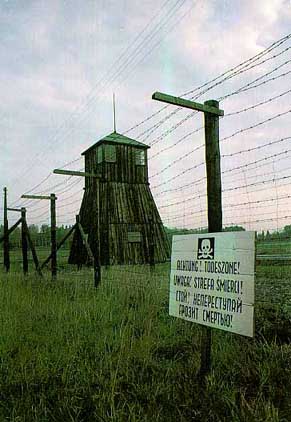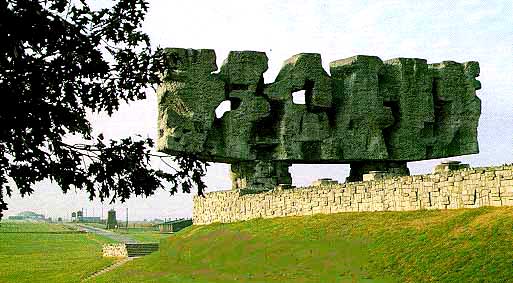Tour of Majdanek Death Camp In October 1998, I went on a guided tour of Poland, which included a trip to the Majdanek extermination camp in Lublin. The camp name is sometimes spelled as Maidanek by Americans and on American TV, some historians pronounce it MY-duh-nek. The Poles always spell the name Majdanek and pronounce it Muh-DON-ek. Lublin does not rhyme with Dublin; it is pronounced Lu-BLEEN. The camp name comes from Majdan Tatarski, an old suburb of Lublin, which formerly had a large Jewish population, and was made into a Jewish ghetto by the Nazis before the concentration camp was opened. The name Majdanek, derived from the name of this suburb, was a nickname given to the camp, soon after it opened in 1941, by local residents who were very much aware of its existence. Getting to the Majdanek camp could not have been easier. From Warsaw, we crossed a bridge over the Vistula river, then drove 157 kilometers south on Highway 17, which goes through a farming region with many small villages and forested areas. We came into Lublin on the Royal Road, an ancient route from Warsaw that took us to the center of the city of Lublin, which is now completely modern and has very little that would be of interest to ordinary tourists. On the way, we passed the home of the Gypsy King which immediately attracted my attention because it is so gaudy and so un-Polish, a white house built in an elaborate style and adorned with statues, like nothing else I had ever seen in Poland. One of the first sights that the tour guide pointed out was the old Castle, high on a hill just east of the Old Town in the city of Lublin, where the Nazis held Polish political prisoners during their occupation of this area of Poland. The castle was built in the 1820ies on the site of King Kazimierz the Great's 14th century fortress. Just below the hill is the location of one of the former Jewish ghettos of Lublin. The Castle now contains a Museum which has a section devoted to the history of the Gestapo prison there. When the Russian liberators were approaching Lublin, the Nazis took all the prisoners at the Castle to Majdanek and killed them just before they retreated. Just like the executions of Polish political prisoners at the "black wall" in Auschwitz, there were also executions of Polish political prisoners in the courtyard of the Castle. Beginning in 1944, prisoners from the Castle were taken to Majdanek for execution. From the Royal Road, we made a right turn in a southeastern direction onto a city street that is the main road leading to Zamosc, Lvov and Chelm, three cities that formerly had large Jewish populations. The new street name of this road, as it goes through Lublin towards the camp, is Street of Martyrs (English translation). This street is part of the main highway that continues on to Kiev in the Ukraine, which was on the Eastern Front in World War II. It was on this same road that German troop trucks and tanks rumbled on their way to invade the Soviet Union in the summer of 1941 and on their way back as they retreated in defeat in the fall of 1943. Immediately on the left, we passed the district known as Majdan Tatarski, the site of the former Jewish Ghetto. We were driving down this broad city street in heavy traffic when suddenly, we came upon the camp on the right hand side. Just after we passed two beautiful, modern Catholic Churches, I saw a low boxwood hedge along the street and behind it, sloping downward, what I first thought was a farm with a white house set back from the road in a lush green field and an old barn behind it. I was amazed when the tour guide said, "That's the camp." I strained to peek through open spots in the hedge to see more of the camp. Then abruptly the guide stopped the car in front of a massive stone monument which is so close to the street that it is difficult to get far enough back from it to take a decent picture. The monument is actually a frame for a massive iron gate which is open and doesn't show in the photograph below.  Seeing this gigantic monument is like being hit between the eyes with a sledge hammer. It is like suddenly coming upon Stonehenge is the middle of a city. The museum guidebook says that this Monument to Struggle and Martyrdom has "a manifold symbolic meaning. It can mean tragedy, but also be an expression of hope and victory." To me it looked like an overdone expression of victory. In a thousand years, this ominous monument will not crumble and will be forever a grim reminder of one of the worst episodes in the history of the world. The view of the monument in the picture above was taken from the street side with the camp in the distance. You can see the round dome of the Mausoleum on the left at the end of the road called the Road of Homage in English. Both the Mausoleum and the Monument were designed by Wiktor Tolkin and were set up in 1969. The photograph below was taken from inside the camp, looking at the back side of the monument. As you can see in the photograph, the grounds of the camp slope down from the street and then gradually slope upwards again towards the Mausoleum and the crematorium building. After you descend the steps on the back side of the Monument, you are on what is now the Road of Homage, but was called the "black path" when the camp was in operation. According to the guidebook, the path was paved with broken tombstones from Jewish cemeteries, just like the road at the Plaszow camp which was shown in Schindler's List.  Unlike some of the other Nazi concentration camps, there was no "Arbeit Macht Frei" sign on the original entrance into the Majdanek camp. At the present tourist entrance, there is a low gate with a wooden frame and barbed wire; it looks like the gate into a cow pasture. Immediately to your right, as you enter through the wooden gate, you see the familiar curved concrete posts and barbed wire which typically surrounded the Nazi concentration camps. In front of this fence is a small parking area for tour buses and a visitor's center, which is like a tiny museum. The visitor's center is open from 8 a.m. to 5 p.m. from May to September, but stays open only to 3 p.m. October to April. The exhibits in the barracks are open until 5 p.m. year round. Entrance to the camp is free, although there is a charge for parking in the narrow parking strip next to the visitor's center. I did not see any guards at the camp and visitors are free to roam around the grounds without a guide, although a two-hour guided tour is available at the Museum in several different languages. There were virtually no other visitors when I was there; although Majdanek has the only Nazi homicidal gas chambers preserved in their original condition, the camp has never achieved the same status as Auschwitz, as a tourist attraction. The tour of the camp starts with a movie,
shown in a large theater at the visitor's center. I was the only
person in the theater for the last showing just before 3 p.m.
A 15-minute documentary put together by the Soviet Union in 1960,
the film shows scenes taken just after the camp's liberation
on July 23, 1944. In the movie, there are scenes of grieving
Polish relatives viewing the bodies of political prisoners who
were brought to the camp from the Gestapo prison at the Castle
in Lublin and shot by the fleeing Nazis just before liberation
day. The movie puts heavy emphasis on the suffering of the Polish
resistance fighters, and doesn't even mention the genocide of
the Jews. Majdanek MuseumField III at MajdanekMausoleum at MajdanekBack to Majdanek indexHome |